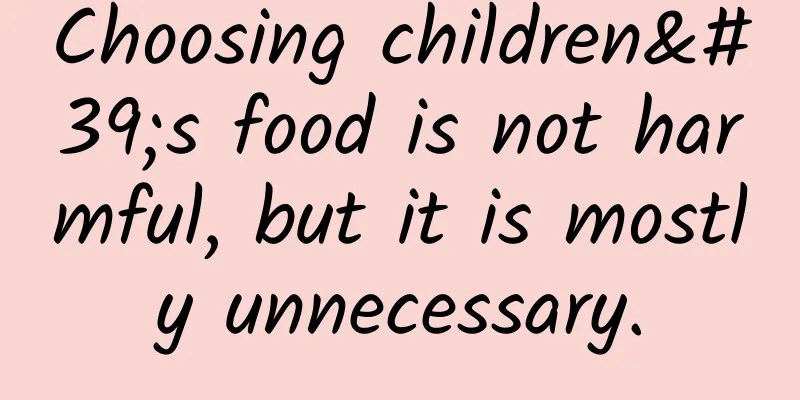Choosing children's food is not harmful, but it is mostly unnecessary.

|
After becoming a mother, a woman will pay special attention to everything about her child, especially in terms of food, and regard safety and health as the top priority. Therefore, many mothers prefer to buy products marked with the word "children", such as children's soy sauce, children's salt, children's honey, children's milk/yogurt, children's cheese, etc., believing that "children's food" must be suitable for children. Image source: Tuchong Creative Are parents' views correct? Are the so-called "children's foods" on the market really suitable for children and beneficial to their health? 1. Children's food, more gimmick than quality When many people hear the term "children's food", they think it is a type of food that is "officially stamped" and is healthier and more conducive to children's growth and development. However, "children's food" does not belong to one of the existing food categories in my country. It is just a concept created by businesses for marketing purposes. This means that even if businesses can take children's nutritional needs into consideration when designing products, they do not need to accept mandatory supervision from government departments. This has led to many children's foods being more focused on attracting children's attention through taste and appearance, rather than necessarily providing children with better nutrition than ordinary adult foods. Some products may even induce children to develop unhealthy eating habits, causing adverse effects on their physical health. The key to measuring whether a food is more suitable for children is not whether there is a word "children" on its packaging, nor whether its advertising slogan promotes that it is more suitable for children. Instead, we should carefully read the food label on its packaging. This is because, according to national regulations, food labels must truthfully and completely mark the category, ingredients, nutrients and other information of the food. We can use this specific information to choose healthy foods for children that have more comprehensive nutrients, lower salt, lower sugar, and less processing. For example, when we see that the salt content of a certain children's food is higher than that of similar ordinary adult food, we can judge that it is not suitable for children. 2. Common children's foods are not "child-friendly" In recent years, there are more and more children's foods on the market. Unfortunately, many popular children's foods are not "child-friendly". According to the "Dietary Nutrition Guidelines for Chinese Residents" and "Guidelines for Snacks for Chinese Children and Adolescents", children's foods should be low in salt (no salt for children under 1 year old), sugar and fat; at the same time, the ingredients should be fresh, nutritious and hygienic. Based on these suggestions, we briefly take stock of several common types of children's foods on the market. Children's soy sauce I don't know when "children's soy sauce" quietly came out, claiming that it is more suitable for children than ordinary soy sauce. After learning that their children cannot eat salt before the age of one, some mothers worry that their children's food will be "tasteless" and choose children's soy sauce instead. As a nutritionist, I do not recommend this practice. First of all, soy sauce generally contains about 12% salt. The diet of children under one year old can keep its natural flavor, and there is no need to use salty condiments such as salt and soy sauce. Even after the child is one year old, if you want to season the food appropriately, there is no need to choose children's soy sauce. There are no corresponding national food safety standards for children's soy sauce currently on the market, and the production process and finished product quality vary greatly. Many types of children's soy sauce that claim to be low in salt are actually not lower in salt than ordinary soy sauce. Taking a domestic brand of children's soy sauce as an example, the sodium content in every 100 ml is 4,600 mg, which is higher than the sodium content of many non-children's soy sauces on the market. The sodium content of many adult light salt soy sauces is around 3,000 mg/100 ml. Based on the intake of 5 ml of the children's soy sauce each time, the sodium intake is 230 mg, which accounts for 1/3 of the recommended daily sodium intake for 1-year-old children (700 mg/day). It can be seen from this that the so-called children's soy sauce is neither low in salt nor low in price, and it is really unnecessary to use it in children's complementary foods. Children's salt A kind of children's cooking salt claiming to be "imported from Japan" is priced at about 30 yuan per 100 grams. It is claimed to be "a must-have for children's complementary food", "suitable for babies over 6 months old", and "the cooking salt loved by Japanese babies"... It is not yet known whether it is deeply loved by Japanese babies. After carefully examining this product, it is found that the difference between it and ordinary table salt is that calcium-containing mineral salts such as "calcium carbonate" and "calcium lactate" are added after the table salt in the ingredient list. I think its high price comes from this. However, as mentioned above, baby food for babies under 1 year old does not need to be seasoned with salt. Some people say, can this kind of children's salt help children supplement calcium? You know, the best source of calcium for children is various milks---high calcium content and good absorption and utilization. Why choose foods that are unnecessary or even harmful to children (eating salt for children under 1 year old will increase the metabolic burden on the kidneys) for such a negligible calcium content? Children's honey Since October 2011, the national food safety standard - honey (GB14963-2011) has been implemented. While everyone is heatedly discussing whether the new national standard has relaxed the regulations on honey hygiene standards and testing items, "new products" such as children's honey and elderly honey that do not have relevant national food safety standards are hot-selling in the market and are still favored by some parents. More than 80% of honey is fructose and glucose, and more than 10% is water. Some varieties have more than 20% of water, and the content of other ingredients is less than 1%. However, large amounts of fructose and glucose are not essential nutrients for infants and young children. Excessive intake can cause indigestion. The key is that honey is not recommended for infants under 1 year old because it may be contaminated by botulinum toxin. The so-called "farm honey" may be made from toxic honey plants collected by bees due to the diversity of nectar sources. So what are the nutritional advantages of "children's honey"? Take a New Zealand imported children's honey as an example. The product introduction mentions "regulating the stomach, promoting defecation, and strengthening the body", which seems to be no different from the effects advertised by general honey. However, these so-called magical effects can be achieved by properly matching complementary foods, increasing dietary fiber and water intake, etc. We would also like to remind you that there are currently no high-quality nutrition or clinical medical research results at home and abroad to prove that honey does have various magical "health effects". Spending a lot of money to buy children's honey, giving children unnecessary sugar and unknown "health ingredients", may also pose food safety risks. Parents need to think deeply about whether this practice is appropriate. Children's cheese I heard that cheese is high in calcium, so many parents buy "kids cheese" for their children. But, have you chosen the right one? At present, my country does not have a national food safety standard for "children's cheese". We can only judge whether "children's cheese" is suitable for children based on the national food safety standard for cheese and the growth and development characteristics and nutritional needs of children. Cheese is a highly concentrated dairy product that is rich in calcium and protein. If it is chosen properly, it is a very healthy food for children. Considering that a large amount of salt is used in the production of cheese, for younger children, excessive salt intake will increase the metabolic burden on their kidneys. Therefore, when choosing cheese for children, we should not look at whether the product is marked with the word "children", but pay attention to the food nutrition label, try to choose products with high calcium content and low sodium content, and at the same time, choose types with clean ingredients, few additives, and low fat content. It can be seen that instead of discussing whether a certain "children's food" is suitable for children, it is more reliable to ask everyone to learn to correctly interpret food labels and choose food suitable for children. The article is produced by Science Popularization China-Starry Sky Project (Creation and Cultivation). Please indicate the source when reprinting. Author: Wang Lu, Chinese registered dietitian, Master of Public Health, Peking University Reviewer: Xue Qingxin, the first nutrition instructor of the National Health Commission, Chinese registered dietitian |
>>: Do you still believe these "anti-baldness" rumors?
Recommend
Causes of right lower abdominal pain in women
In our daily life, abdominal pain occurs from tim...
What is the cause of blood in the vaginal discharge after menstruation?
Menstruation is the most important physiological ...
Can I drink coffee during my period?
Coffee has a very good refreshing effect, so offi...
It's not a cold, it's just a flu! Beware of the "grass killer" scrub typhus
Grandma Zhong, a 76-year-old woman from Jiangxi P...
How to overcome the fear of having children?
Generally speaking, after getting married, women ...
How big is the gestational sac at 6 weeks of pregnancy
Pregnancy is very important for women, and the bo...
Why do some people feel “bad mentally” during mental health week?
In today's society, mental and psychological ...
Lochia color changes after cesarean section
Postpartum lochia is a sign of the quality of ute...
How to use salt to reduce breast size?
Many women have big breasts. Of course, these bre...
How long does it take for menstruation to return to normal after an abortion?
The bleeding time after artificial abortion is ge...
Does bleeding during pregnancy affect the fetus?
Constipation is a problem that every girl should ...
Is it better to have a cesarean section in the morning or in the afternoon? What is the best time of the day for a cesarean section?
We all know that cesarean section is a common way...
What are the symptoms of low estrogen in pregnancy?
Estrogen is especially important for pregnant wom...
What are the steps to grill lamb chops? What beverages are good to drink with barbecue?
You may ask: Isn't barbecue just putting meat...

![[Medical Q&A] Does yellow nasal discharge necessarily mean a bacterial infection?](/upload/images/67f0fe4e8457e.webp)







